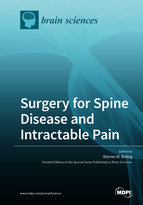Surgery for Spine Disease and Intractable Pain
A special issue of Brain Sciences (ISSN 2076-3425).
Deadline for manuscript submissions: closed (30 November 2019) | Viewed by 41642
Special Issue Editor
Interests: epilepsy; surgery; neurosurgery
Special Issues, Collections and Topics in MDPI journals
Special Issue Information
Dear Colleagues,
Painful conditions and spinal disease are highly prevalent in society, resulting in a significant impact on the individual due to the disability of the condition and direct costs of treatment. Furthermore, society is affected by the indirect costs and a loss of productivity. In one study from Nordic countries, more than half of individuals reported back pain in the past 12 months (Ihlebaek, TH, et al., Scandinavian Journal of Public Health, 2006), and more than 20% of these individuals had a work absence due to back pain. The most common musculoskeletal pains reported are shoulder, low back, and chronic widespread pain (McBeth J, et al., Best Practice & Research Clinical Rheumatology, 2007), and the total cost of musculoskeletal related pain conditions in the USA has been estimated at $215 billion. Direct medical costs accounted for 41% of the total, and the remaining were indirect costs associated with the morbidity or mortality of the condition (Baldwin ML, Journal of Electromyography and Kinesiology, 2004). An additional burden of pain is found in cancer patients, among whom one half or more experience moderate to severe pain (Paice JA, Oncology, 2018). In the United States, 1,735,350 new cancer cases are projected to occur in 2018, whereas the lifetime probability of being diagnosed with invasive cancer in the United States is over 37% (Siegel RL, et al, Cancer statistics, 2018). Data from National Hospital Ambulatory Medical Care Survey identified that headache or pain in the head was the fifth leading cause of visits to the Emergency Department overall and the third leading patient-reported reason for ED visits for women aged 15–64 (Smitherman TA, et al, Headache, 2013).
The burden of painful conditions and spinal disease is enormous. However, the current opioid crisis has demonstrated the serious limitations of medical therapy for the treatment of pain, which means that more urgently then ever our patients need effective and safe surgical options to lessen the disability and reduce the burden of intractable pain. This Special Issue of Brain Sciences will be devoted to investigations and reviews of surgical treatments and approaches that are available today or may soon become available to effectively treat intractable pain and spinal conditions.
Dr. Warren W. Boling
Guest Editor
Manuscript Submission Information
Manuscripts should be submitted online at www.mdpi.com by registering and logging in to this website. Once you are registered, click here to go to the submission form. Manuscripts can be submitted until the deadline. All submissions that pass pre-check are peer-reviewed. Accepted papers will be published continuously in the journal (as soon as accepted) and will be listed together on the special issue website. Research articles, review articles as well as short communications are invited. For planned papers, a title and short abstract (about 100 words) can be sent to the Editorial Office for announcement on this website.
Submitted manuscripts should not have been published previously, nor be under consideration for publication elsewhere (except conference proceedings papers). All manuscripts are thoroughly refereed through a single-blind peer-review process. A guide for authors and other relevant information for submission of manuscripts is available on the Instructions for Authors page. Brain Sciences is an international peer-reviewed open access monthly journal published by MDPI.
Please visit the Instructions for Authors page before submitting a manuscript. The Article Processing Charge (APC) for publication in this open access journal is 2200 CHF (Swiss Francs). Submitted papers should be well formatted and use good English. Authors may use MDPI's English editing service prior to publication or during author revisions.
Keywords
- pain
- spine and spinal disease
- surgery
- intractable pain







